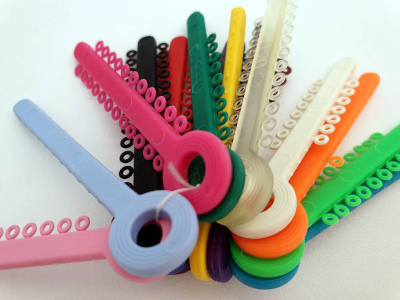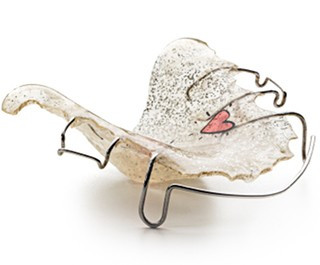Types of Braces
FIXED BRACES CERAMIC COSMETIC BRACES REMOVABLE RETAINERS EXPANDER BRACES
Dental braces are devices used in orthodontics to align and straighten teeth and jaws by helping to position them, while correcting crooked teeth and undesirable gaps. There are various types , each with different goals, including: fixed, non-removable braces made up of metal brackets, ceramic cosmetic , lingual, Damon System, and a retainer or expanders from Invisalign. The universe of braces is large, diverse, and always adaptable to different problems and solutions.
Fixed braces are the most common type. They enable higher control regarding planning of the treatment by the dentist and are more effective as a result. These braces stay fixed with brackets glued onto the teeth. Fixed braces have bands (metal rings), wires, brackets, and modules (elastic rings). The component glued onto each tooth is called a bracket. Orthodontists use them to apply pressure on the teeth.
The dentist adjusts fixed braces monthly and, with this gentle pressure, teeth will move into their correct position. Braces are usually made of a light, metal material. Stainless steel is commonly used on braces due to its biocompatibility and endurance. The treatment usually takes anywhere from one to two years, but varies according to the severity of the orthodontic problem. Regular attendance of follow up appointments is crucial for success of the treatment.
| Braces materials | ||
|---|---|---|
 |
Bands | Bands or metal rings are fixed around one or several teeth. They act as an anchor for braces. |
 |
Brackets | Brackets are externally cemented to each tooth and are generally made of metal. |
 |
Wire | Arch wires connect the brackets and are fixed on bands. |
 |
Modules | The wire is held in place with small elastic rings called modules and come in a variety of colours. |
 |
Hooks | Can be a part of the brackets. Hooks can be attached to the wires or surround the brackets. They attach the modules. |
Cosmetic Braces
Cosmetic Braces have the same purpose as conventional metal braces, which is to correct misaligned and crooked teeth. The demand for cosmetic braces has grown in recent years. Patients want to correct misaligned teeth without undermining their appearance.
There are 3 material types:
- Plastic (polycarbonates): Composed of acrylic material and have a discreet appearance. They are more affordable compared to other cosmetic braces. However, these braces are less resistant and brackets may break or detach themselves more easily. Also, the colour of the braces may change over time due to the absorption of the pigment. These changes are directly linked to the patient’s eating or other general habits;
- Ceramic: Owing to the characteristics of the used material, these braces are extremely resistant to discoloration. There is less abrasion between brackets and the wire is more effective. It is more expensive than the above-mentioned cosmetic braces;
- Sapphire: These brackets are so transparent that they are hard to notice. There will be no colour changes and they rarely detach or break. Radiance braces are virtually invisible (only the wire is slightly noticeable), which allows you to maintain a great appearance.
Braces Colours

The modules used on the braces can have several different colours. These modules are produced with elastomers and are replaced monthly during follow up appointments.
These modules are used to hold the arch wire tied to the brackets (small components glued on the teeth). Modules are what add colour to braces and are available in almost every colour. You can choose among green, yellow, silver, red, pink, white, and purple.
Patients can choose a favourite colour to match their clothing or mood, for example. The chosen colour is not permanent; therefore, it can be changed every month during the regular appointments.
Retainers
Removable retainers are recommended for children with our without permanent teeth in order to influence their development. They are highly effective for children up to the age of 12.
Retainers are also recommended to teenagers with slightly misaligned teeth. These are often used at the final stage of fixed treatment. As its name suggests, retainers are removable and can be pulled out during meals and cleaning.
 Retainers have an acrylic, plastic, or metal base that will fit on the teeth. It is generally to keep the teeth straight at the end of a course of fixed treatment. These devices prevent teeth from drifting back to their original position. The maxillary bone, lips, tongue, and face will need to adapt to this new positioning of the teeth. Retainers are generally fitted for a few months at the end of an orthodontic treatment. The aim is to ensure teeth stay in their place after the braces have been removed. They can also be used to discourage children from sucking their thumb. The various types of removable braces have different goals, such as encouraging bone growth with orthopaedic braces, repositioning teeth through orthodontic plates, and holding teeth in their new position.
Retainers have an acrylic, plastic, or metal base that will fit on the teeth. It is generally to keep the teeth straight at the end of a course of fixed treatment. These devices prevent teeth from drifting back to their original position. The maxillary bone, lips, tongue, and face will need to adapt to this new positioning of the teeth. Retainers are generally fitted for a few months at the end of an orthodontic treatment. The aim is to ensure teeth stay in their place after the braces have been removed. They can also be used to discourage children from sucking their thumb. The various types of removable braces have different goals, such as encouraging bone growth with orthopaedic braces, repositioning teeth through orthodontic plates, and holding teeth in their new position.
Expander
The palatal expander is fixed and often used to widen the upper jaw teeth. It is a plastic device, which fits over the roof of the mouth.
The maxillary bone dimension needs to be higher than the mandible bone in order to fit correctly and allow for normal occlusion.
There are several causes that lead to an overly small roof of the mouth, such as respiratory problems, thumb-sucking, premature loss of baby teeth, or if these teeth stay in longer than the usual. Persons with cleft lip and palate usually have a narrow roof of the mouth. The appropriate age to treat this problem is from ages 10-15. Treatment at this age will be more effective and cause less discomfort. However, older patients can also be successfully treated. Over time, there is an increase of bone strength, which will have an influence on the complexity and success of the orthodontic treatment. There are various devices used to expand your upper jaw. The placement of this device is simple and effective.
- Hyrax Expander
- McNamara Expander
- Haas Expander
- Invisalign

